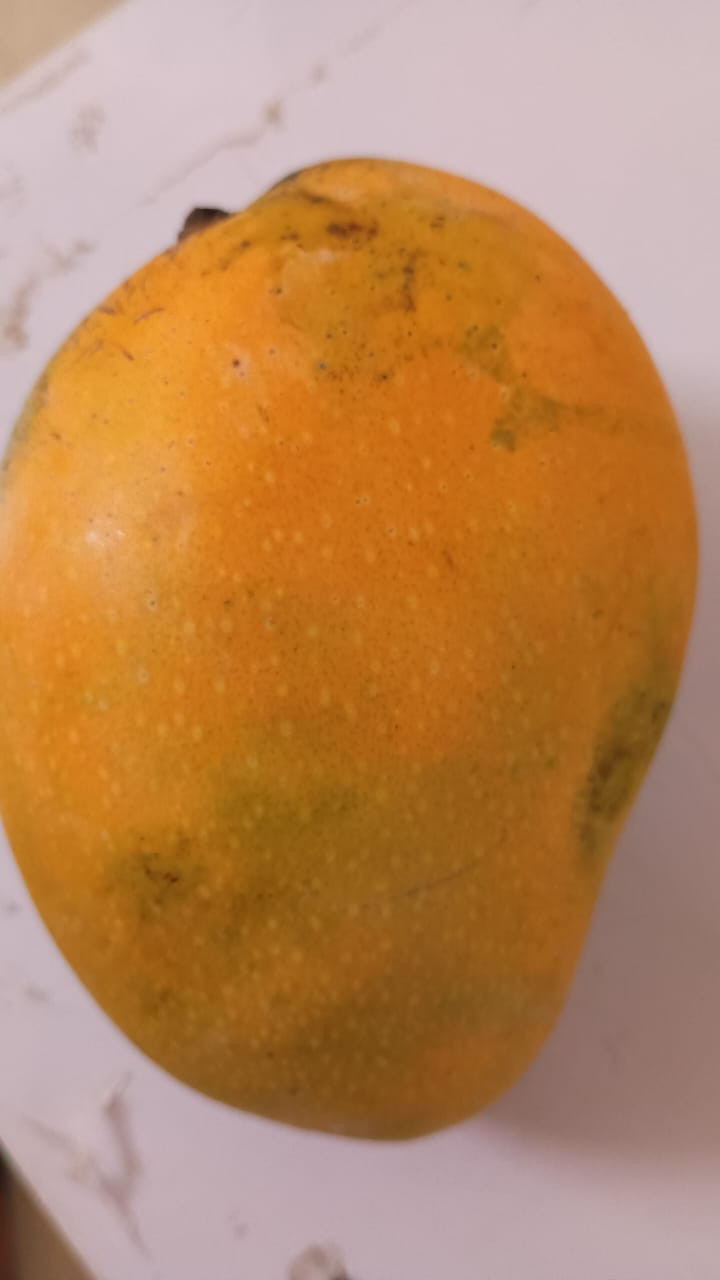The ‘Mallika’ mango is the result of the hybridization of the Indian mango varieties Neelum and Dasheri. The variety was introduced by Dr. Ramnath Singh. When grafted, the tree will remain a manageable size and is appropriate for dooryard growing. Fruit is normally ready to harvest from June to July.

Mallika produces high quality, fiberless Mango fruit. The fruit has prominent citrus, melon and honey notes and is exceptionally sweet. The cultivar met a positive reception at the Fairchild Botanic Gardens International Mango Festival. Mallika are usually grown in tropical to subtropical climates. However, if grown in colder temperatures, the Malika has a higher chance of showing signs of a disease called malformation. Malformation is most prevalent in species of mango that are grown between a range of temperatures of 10-15 degrees Celsius. However, the sign of the disease is not as prevalent in temperatures that are higher than 15 degrees Celsius. The reason for the malformation in the Mallika species is due to the cold temperature causing the mango to produce higher than normal levels of ethylene, which is a chemical produced when the mango exhibits either abiotic or biotic stresses.
After the initial day of harvest, the Mallika changes in physical attributes and chemical structure. Three days after harvesting the Mallika mangos, the color of the skin becomes a reddish yellowish hue. This is due to an increase in the number of carotenoids present within the skin while the chlorophylls start to degrade. The mango is also the most acidic and has the firmest texture on the third day after harvest, but the level of acidity and firmness decreases drastically afterwards. The mango becomes the heaviest on the fifth day after harvest but the size of the mango becomes the smallest by the seventh day after harvest.
Q&A About Murshidabad Mango “Mallika”
Q1: What is the “Mallika” mango?
A1: The “Mallika” mango is a popular variety of mango known for its sweet, rich flavor and smooth, fiberless texture. It is a hybrid of the Neelum and Dasheri mangoes, combining the best qualities of both. The “Mallika” mango is prized for its deep orange flesh and aromatic fragrance.
Q2: Where is the “Mallika” mango grown?
A2: The “Mallika” mango is primarily grown in Murshidabad, a district in the state of West Bengal, India. Murshidabad has a long history of mango cultivation, and its climate and soil conditions are ideal for producing high-quality mangoes, including the “Mallika” variety.
Q3: What makes Murshidabad mangoes, especially “Mallika,” unique?
A3: Murshidabad mangoes, particularly the “Mallika” variety, are renowned for their exceptional sweetness, juiciness, and rich flavor. The region’s unique soil composition, combined with favorable climatic conditions, contributes to the distinctive taste and quality of these mangoes. Additionally, traditional cultivation practices and careful selection of mango varieties have maintained the high standards for which Murshidabad mangoes are known.
Q4: When is the “Mallika” mango season?
A4: The “Mallika” mango season typically runs from late May to July. During this period, the mangoes reach their peak ripeness and are widely available in local markets. The precise timing can vary slightly depending on weather conditions each year.
Q5: How can one identify a “Mallika” mango?
A5: A “Mallika” mango can be identified by its oblong shape and smooth, golden-yellow skin with a slight blush of red when ripe. The mango has a relatively thin skin compared to other varieties. When cut open, the flesh is deep orange, almost fiberless, and has a rich, sweet aroma.
Q6: What are the nutritional benefits of “Mallika” mangoes?
A6: “Mallika” mangoes are rich in vitamins and minerals. They are an excellent source of Vitamin C, Vitamin A, and Vitamin E, which are essential for maintaining a healthy immune system and skin health. They also contain dietary fiber, which aids in digestion, and antioxidants that help protect the body against free radicals.
Q7: How should “Mallika” mangoes be stored?
A7: “Mallika” mangoes should be stored at room temperature until they ripen. Once ripe, they can be kept in the refrigerator to extend their shelf life by a few days. It is best to consume them within a few days of ripening to enjoy their optimal flavor and texture.
Q8: What are some popular uses of “Mallika” mangoes in culinary preparations?
A8: “Mallika” mangoes are versatile and can be used in a variety of culinary preparations. They are commonly eaten fresh, as a dessert or snack. They can also be used in smoothies, salads, salsas, and chutneys. Additionally, “Mallika” mangoes are excellent for making mango pulp, which can be used in beverages, ice creams, and desserts like mango mousse and sorbet.
Q9: Are there any specific cultural or traditional significances associated with “Mallika” mangoes in Murshidabad?
A9: In Murshidabad, mangoes, including the “Mallika” variety, hold cultural significance and are often featured in local festivals and celebrations. Mangoes are considered a symbol of prosperity and are exchanged as gifts during the summer season. The region’s rich history of mango cultivation also adds to the cultural heritage associated with these fruits.
Q10: Where can one buy “Mallika” mangoes?
A10: During the mango season, “Mallika” mangoes can be purchased at local markets in Murshidabad and other parts of West Bengal. They are also available in major cities across India and can sometimes be found in specialty fruit stores and online marketplaces that offer fresh, seasonal produce.
Pingback: Health Benefits of Cardamom - Dr. Sudipto Banerjee